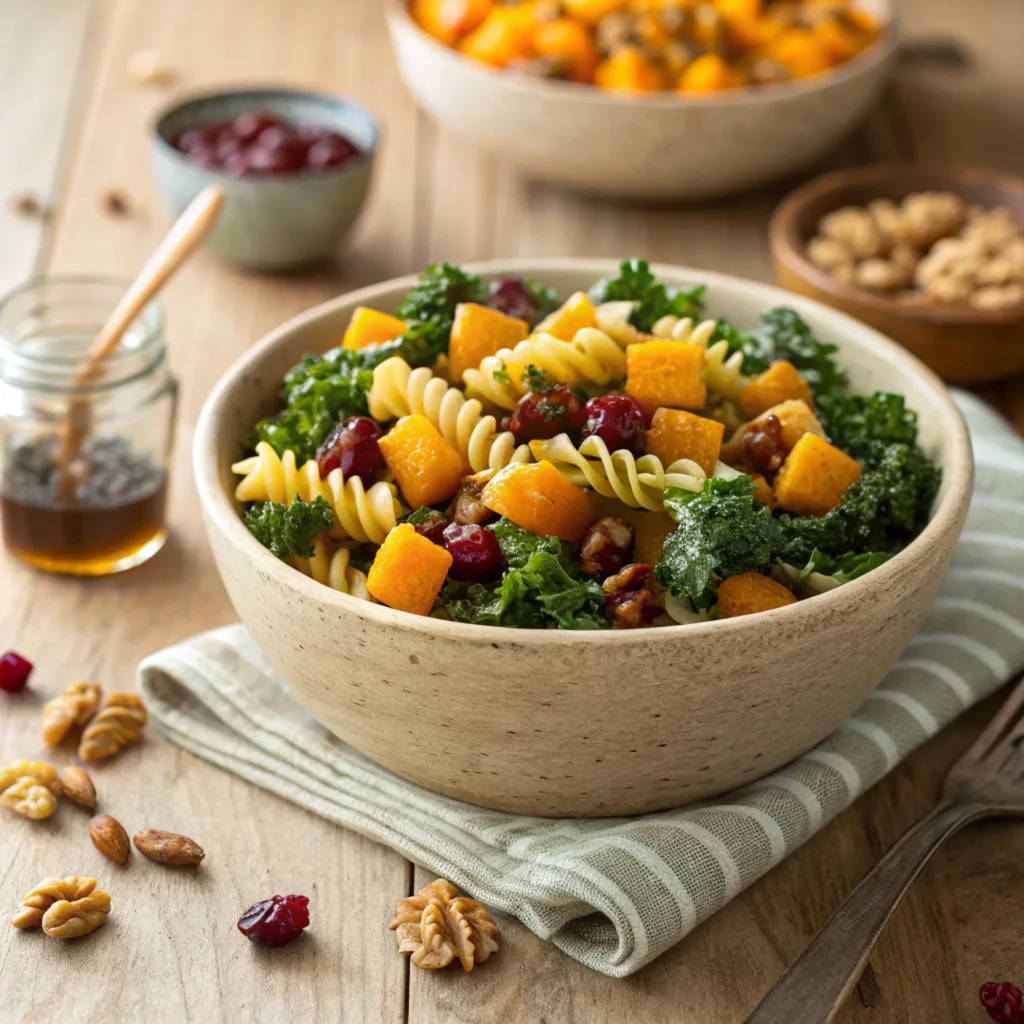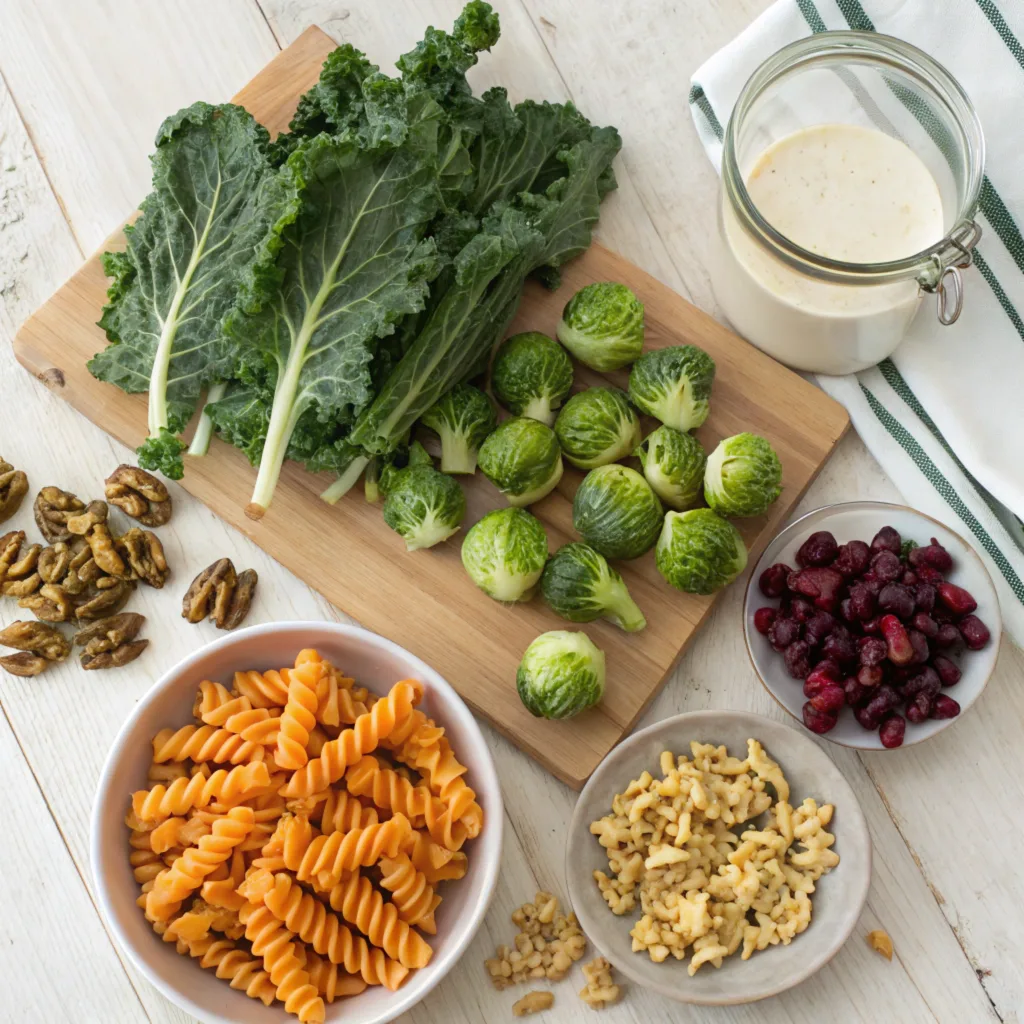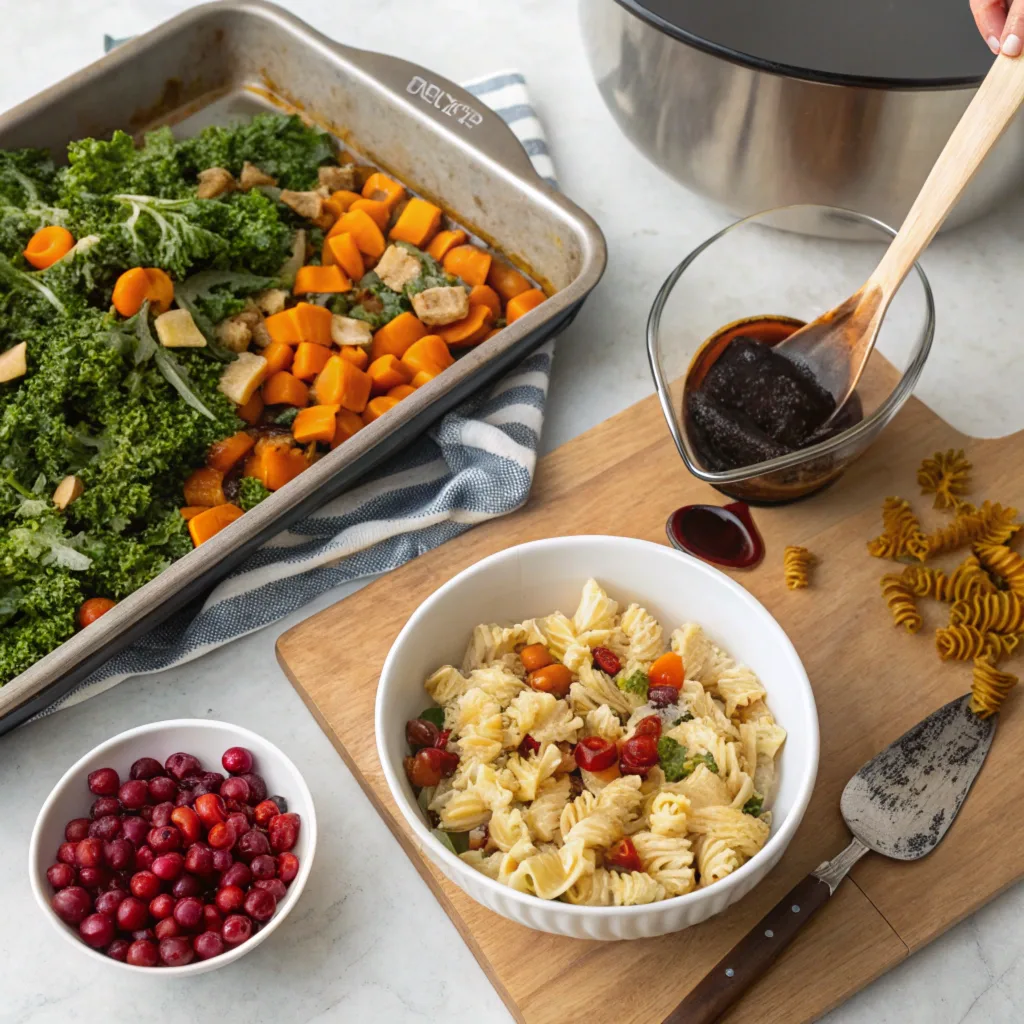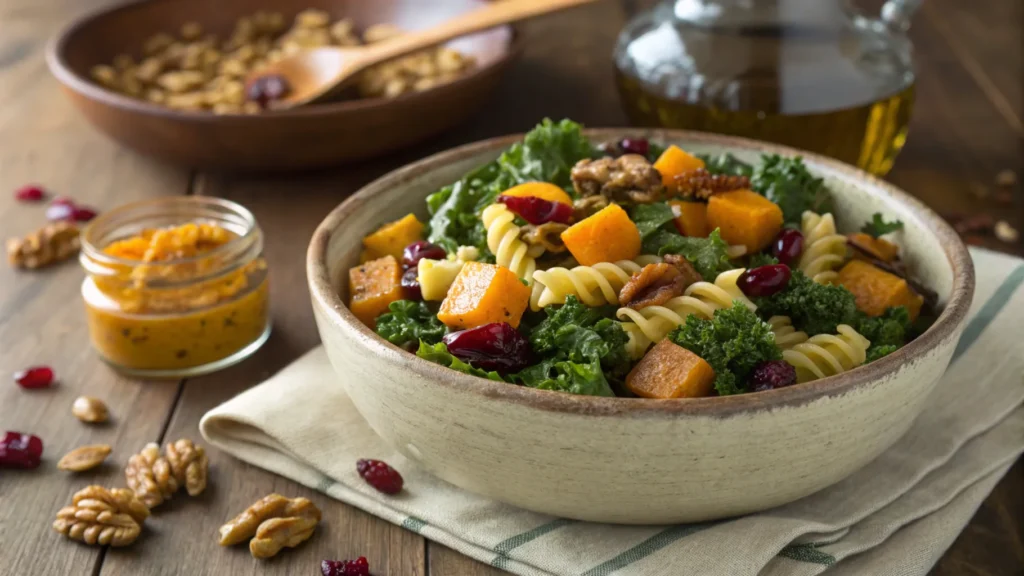Winter days make me crave something hearty yet refreshing—a dish that’s both satisfying and doesn’t feel too heavy. Winter pasta salad is that perfect balance. Packed with fresh ingredients, easy to whip up, and versatile enough to suit your taste, it’s a go-to for both cozy nights and dinner parties. If you’re in the mood for something equally comforting but a bit different, check out this Prosciutto Arugula Pizza for another winter favorite. Let’s get into the details and make this cold-weather staple a breeze for you.

Ingredients for Winter Pasta Salad
A good winter pasta salad starts with the right ingredients. You don’t need anything fancy; just a mix of pantry staples and some fresh additions.
Essentials:
- Pasta: Short pasta like rotini, penne, or farfalle works best. It holds the dressing beautifully.
- Greens: Kale or spinach is perfect—they’re sturdy and don’t wilt easily.
- Roasted Veggies: Think sweet potatoes, Brussels sprouts, or butternut squash.
- Protein: Grilled chicken, chickpeas, or even cubed cheese add that filling factor.
- Dried Fruits and Nuts: Cranberries or raisins for sweetness, walnuts or almonds for crunch.
- Dressing: A tangy balsamic vinaigrette or a creamy yogurt-based dressing ties it all together.

Pro tip: Use whatever’s in your fridge or pantry. The best part about winter pasta salad is how forgiving it is!
Tools and Equipment Needed
Making this dish doesn’t require any fancy gadgets, but having the right tools on hand makes life so much easier.
What You’ll Need:
- Large Pot: For boiling your pasta.
- Baking Sheet: To roast those winter veggies.
- Mixing Bowl: A big one, so you can toss everything without making a mess.
- Sharp Knife: For chopping greens, veggies, and proteins.
- Whisk: For whipping up the dressing.
- Tongs or Salad Servers: To toss the salad evenly.
Most of these you probably already have, and if not, don’t stress—improvise! For instance, a fork works just fine for mixing a simple dressing.
How to Make Winter Pasta Salad: Step-by-Step Guide
Let’s break it down further to guarantee every step of making winter pasta salad is a smooth and flavorful experience. Each step can be fine-tuned depending on your preferences, so feel free to get creative as you go.
1. Cook the Pasta
Start by bringing a large pot of water to a rolling boil. Add a generous handful of salt—this is your chance to season the pasta from the inside. Choose a sturdy pasta like penne, fusilli, or bowties that can hold up to the hearty winter ingredients.
- Cook until al dente. This means the pasta should be tender but still have a slight firmness when bitten.
- Immediately drain and rinse the pasta under cold water. This step not only cools the pasta but also prevents it from clumping.
- Toss the drained pasta with a teaspoon of olive oil to keep it from sticking together.
Tip: Don’t skip rinsing the pasta; it helps to remove excess starch, keeping the salad light and fresh.
2. Roast the Veggies
The roasted veggies are what give this salad its seasonal charm and depth of flavor.
- Preheat your oven to 400°F. While it heats, chop winter favorites like sweet potatoes, Brussels sprouts, and red onions into bite-sized pieces.
- Place the veggies on a baking sheet and drizzle with olive oil. Season generously with salt, pepper, and, if you like, a sprinkle of smoked paprika or thyme for extra warmth.
- Spread the veggies in a single layer to guarantee even roasting. Crowded veggies will steam rather than caramelize.
- Roast for 20-25 minutes, flipping halfway through. They’re ready when they’re golden brown and fork-tender.
Pro tip: Add a handful of chopped garlic or shallots to the roasting pan for a burst of extra flavor.
3. Make the Dressing
Homemade dressing raises this dish from good to great and doesn’t take much time.
- In a small bowl or jar, whisk together:
- 1/3 cup olive oil
- 2 tablespoons balsamic vinegar
- 1 teaspoon Dijon mustard
- 1 teaspoon honey (or maple syrup for a vegan option)
- 1 minced garlic clove
- A pinch of salt and freshly ground pepper
- Shake or whisk until emulsified.
Taste your dressing before using. Too tangy? Add a bit more honey. Too mild? A splash of vinegar can brighten it up.
Quick fix: If you’re short on time, a high-quality bottled balsamic vinaigrette can work in a pinch, but homemade always tastes fresher.
4. Assemble the Salad
Now it’s time to bring everything together into one colorful, flavor-packed dish.
- In a large mixing bowl, combine the cooked pasta, roasted veggies, and a handful of chopped greens like kale or spinach. The greens will wilt slightly from the warmth of the roasted veggies, which adds a lovely texture.
- Add your protein of choice—think grilled chicken, roasted chickpeas, or diced tofu for a vegetarian twist.
- Pour the dressing over the top, starting with about half and adding more as needed. Toss gently to avoid breaking up the veggies.
Tip: Make sure the ingredients are well-mixed so every bite is balanced with flavors and textures.

5. Garnish
The final step is all about adding those little touches that make your winter pasta salad truly special.
- Sprinkle on dried cranberries or golden raisins for a hint of sweetness.
- Add a handful of toasted walnuts, almonds, or sunflower seeds for crunch.
- Finish with a sprinkle of cheese—crumbled feta or shavings of Parmesan work beautifully.
Optional extras: A squeeze of lemon juice or a few fresh herbs like parsley or basil can add a bright, fresh note just before serving.
With these detailed steps, you’ll not only have a delicious winter pasta salad but also one that feels just as rewarding to make as it is to eat. Whether you’re preparing it for a weeknight dinner or a weekend potluck, this salad is a guaranteed hit.
Tips for Winter Pasta Salad
Nobody likes soggy salads or overly bland bites. These tips will help you nail it every time:
- Cool the Pasta Properly: Rinsing it under cold water not only stops the cooking but also keeps it from clumping together.
- Season as You Go: Add a pinch of salt at every stage—pasta, veggies, and dressing. It layers the flavor.
- Don’t Skip the Crunch: Nuts or seeds bring texture, so don’t leave them out.
- Serve Fresh or Make Ahead: While it tastes amazing fresh, this salad holds up for a day or two in the fridge. Just keep the dressing separate and toss before serving.
Quick fix: If you’re short on time, grab pre-washed greens and pre-chopped veggies. It’s not cheating; it’s smart cooking.
Variations of Winter Pasta Salad
One of the joys of winter pasta salad is its flexibility. You can tweak it endlessly to suit your mood or what’s in your fridge.
Mediterranean Twist
- Swap the balsamic dressing for lemon-olive oil.
- Add olives, sun-dried tomatoes, and crumbled feta.
- Use arugula for a peppery kick.
Vegan Delight
- Skip the cheese and use tahini dressing.
- Load up on roasted chickpeas for protein.
- Sprinkle with nutritional yeast for a cheesy vibe.
Meaty Edition
- Toss in shredded rotisserie chicken or leftover turkey.
- Bacon bits add smoky goodness.
- Try a creamy ranch dressing for a rich flavor.
Spicy Option
- Add sliced jalapeños or red pepper flakes.
- Use a sriracha-lime dressing for a bold punch.
- Top with spicy candied pecans.
The possibilities are endless. Play around, mix it up, and make it your own!
Nutritional Benefits of Winter Pasta Salad
When it comes to winter pasta salad, it’s not just about flavor—it packs a punch in terms of nutrients too. Combining hearty veggies, protein-rich additions, and pasta, this dish is more balanced than you might think.
- Veggie Power: Roasted sweet potatoes or Brussels sprouts bring vitamins like C and K, along with fiber to keep you full. Kale or spinach adds antioxidants and iron.
- Protein Boost: Adding grilled chicken, chickpeas, or even hard-boiled eggs makes it filling. Protein also helps with muscle recovery after a long day.
- Healthy Carbs: Pasta provides a source of energy, especially if you choose whole-grain varieties.
- Smart Fats: Dressings made with olive oil add heart-healthy fats.
It’s the kind of meal that doesn’t just taste good—it makes you feel good, too. Perfect for a light lunch or post-workout bite.
Storage and Reheating Tips for Winter Pasta Salad
Making winter pasta salad ahead? Smart move. But keeping it fresh and tasty requires a few tricks.
- Refrigeration: Store the salad in an airtight container for up to three days. If using greens like arugula, keep them separate until serving to prevent wilting.
- Dressing on the Side: Always keep the dressing in a small container if you’re not eating the salad right away. Tossing it fresh before serving makes all the difference.
- Reheating Roasted Veggies: If you want the veggies warm, a quick zap in the microwave or a toss in a skillet will do. Don’t heat the entire salad—just the veggies.
- Reviving the Salad: If the pasta seems dry after a day or two, add a splash of olive oil or a fresh squeeze of lemon to brighten it up.
These small steps keep leftovers just as good as day one.
Serving Suggestions for Winter Pasta Salad
Wondering how to serve winter pasta salad? It’s as versatile as they come.
- As a Main Dish: Add grilled chicken, shrimp, or tofu to make it more filling. A sprinkle of Parmesan or goat cheese raises the flavor.
- As a Side: Pair it with roasted salmon or a hearty stew for a well-rounded meal.
- Potluck Star: It holds up well at room temperature, making it great for gatherings.
- In a Wrap: Use the salad as a filling for whole-grain wraps. It’s a quick and satisfying lunch option.
No matter how you serve it, this salad is always a crowd-pleaser.
FAQs
Should prosciutto go on pizza before or after cooking?
Prosciutto is delicate and already cured, so it’s best added after cooking. The residual heat warms it up without making it dry or overly crispy.
Should I put arugula on my pizza before or after cooking?
Arugula works best added after cooking. Its peppery bite and fresh texture balance the richness of pizza toppings like cheese and meats.
Is prosciutto pizza healthy?
It depends on the portion and toppings. Prosciutto is high in sodium but also provides protein. Pairing it with arugula and lighter cheeses can make it a more balanced choice.
What does arugula taste like on pizza?
Arugula adds a peppery and slightly nutty flavor that cuts through the richness of the pizza. It’s a fresh and vibrant addition.
A Beginner’s Guide to Winter Pasta Salad
Starting out with winter pasta salad? Here’s how to nail it every time.
- Pick the Right Pasta: Short shapes like penne or farfalle hold up best and mix easily.
- Choose Seasonal Veggies: Think roasted squash, kale, or carrots. They’re easy to prep and taste great cold.
- Prep Ahead: Roast veggies and cook pasta the night before. It’s a time-saver.
- Dress It Right: Whisk up a simple vinaigrette with olive oil, lemon juice, and Dijon mustard. No need for fancy store-bought options.
The key is to keep it simple and focus on fresh flavors.
Advanced Tips for Winter Pasta Salad
Once you’ve mastered the basics, take your winter pasta salad to the next level.
- Layer Flavors: Toss warm pasta with a little dressing before adding other ingredients. It absorbs more flavor this way.
- Seasoned Veggies: Add spices like smoked paprika or cumin to roasted vegetables for an unexpected twist.
- Texture is Key: Include something crunchy like toasted nuts or seeds.
- Mix Dressings: Combine balsamic and yogurt-based dressings for a creamy yet tangy flavor.
Experimentation is the secret to making this dish truly yours.
The Appeal of Winter Pasta Salad
Why does winter pasta salad hit the spot? It’s simple: it’s comforting without being overly indulgent.
- It’s versatile—you can swap ingredients to fit your pantry.
- It works for any occasion, from weekday lunches to weekend gatherings.
- It’s a great way to use seasonal produce creatively.
Plus, the balance of warm roasted veggies and cool greens makes it perfect for those in-between days where you can’t decide if you want something light or hearty.
Homemade vs. Store-Bought Winter Pasta Salad
Should you make winter pasta salad from scratch or grab a pre-made version? Both have their merits.
Homemade:
- Control over ingredients and flavors.
- Fresher and often cheaper.
- Customizable for dietary preferences.
Store-Bought:
- Convenient for busy days.
- Usually consistent in flavor.
- A good backup when time is tight.
Making it yourself lets you adjust to your liking, but pre-made versions can be a lifesaver in a pinch.
Conclusion
Winter pasta salad isn’t just a dish—it’s an easy, adaptable way to enjoy the best of the season. Whether you’re throwing it together for a quick dinner or prepping for the week, it’s a recipe that fits into almost any routine. So grab your favorite ingredients and try it out—you might just find your new winter staple.


